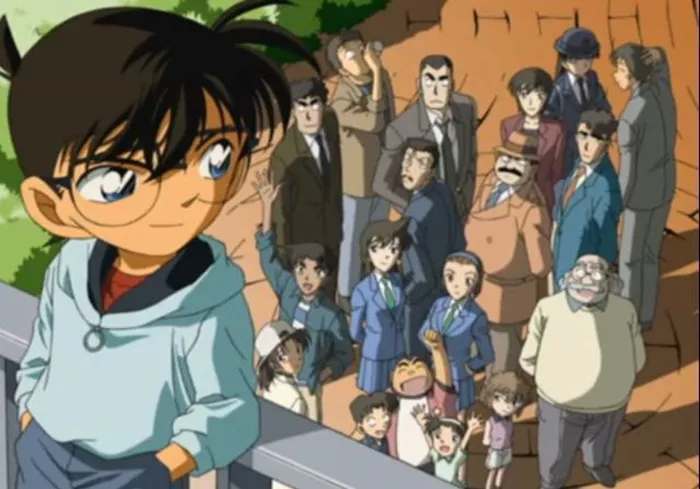Gosho Aoyama, a Japanese manga artist born on June 21, 1963, is the brilliant mind behind the wildly popular Detective Conan series, known as Case Closed in the United States, Canada, and the United Kingdom. With over 105 tankōbon volumes and a dedicated fan base worldwide, Detective Conan has become a cultural phenomenon, captivating readers and viewers with its intricate mysteries and endearing characters.
Early Life and Career Beginnings
Aoyama’s journey as a manga artist began during his university years when he submitted a manga work that earned an honorable mention from a magazine. After graduating from Nihon University College of Art, he won the Newcomer Award at Shueisha’s Weekly Shōnen Sunday magazine with his short story “Wait a Minute.”
Breakthrough with Magic Kaito and Yaiba
In the early stages of his career, Aoyama created the manga series Magic Kaito, which caught the attention of his editor-in-chief. The editor-in-chief offered to treat Aoyama if Magic Kaito was made into volumes and sold 100,000 copies, a goal that was quickly surpassed. This success led to the publication of Aoyama’s profitable series Yaiba in Weekly Shōnen Sunday, which helped stabilize his financial and psychological well-being.
The Birth of Detective Conan
After wrapping up Yaiba, Aoyama’s editors asked him to develop a mystery manga, hoping to match the popularity of The Kindaichi Case Files. This request prompted Aoyama to create Detective Conan, a series that would go on to captivate readers worldwide. Aoyama claimed that the plot for Detective Conan was planned in just two weeks.
Initially, Aoyama considered creating a hardboiled series, but he ultimately decided on a more lighthearted idea where a teenage boy, Shinichi Kudo, is transformed into a child and forced to go undercover as a first-grader named Conan Edogawa. With this premise in mind, Aoyama planned to include a significant amount of romantic comedy centered around the shrunken protagonist and his teenage love interest, Ran Mouri.
Character Design and Series Development
Aoyama deliberately broke from standard convention when designing Conan. He gave the character glasses, inspired by the Clark Kent persona from Superman, and a long name, Conan Edogawa, a combination of the names of Sir Arthur Conan Doyle and Ranpo Edogawa, two renowned mystery writers. Aoyama’s editor-in-chief initially expressed concern that Conan’s name was too similar to Future Boy Conan and requested that Aoyama change it to Doyle, but the creator ultimately kept the name Conan Edogawa.
Despite his editor’s belief that Detective Conan would only last three months, Aoyama’s series quickly gained popularity and has continued to run for nearly three decades. The manga has been serialized in Weekly Shōnen Sunday since January 1994, with its chapters collected into 105 tankōbon volumes as of April 2024.
See Also: Is Detective Conan Worth Watching?
Anime Adaptation and Global Expansion
The success of Detective Conan’s manga led to an anime television series adaptation produced by Yomiuri Telecasting Corporation and TMS Entertainment, which premiered in January 1996. The anime series has since spawned numerous animated feature films, original video animations, video games, audio disc releases, and live-action episodes.
To overcome legal issues with the name Detective Conan, the English language releases from Funimation and Viz Media were renamed to Case Closed. The anime series premiered on Adult Swim in North America in 2003 but was discontinued due to low ratings. In March 2013, Funimation began streaming their licensed episodes of Case Closed, while Crunchyroll simulcast them in 2014.
Funimation also localized the first six Case Closed films, while Discotek Media localized the Lupin III crossover special, its film sequel, and select films, starting with Case Closed Episode One. Meanwhile, the manga was localized by Viz Media, which used Funimation’s changed title and character names. Shogakukan Asia also created its own localized English version of the manga, which used the original title and Japanese names.
Popularity and Awards
Detective Conan has gained immense popularity worldwide, with translations into numerous languages, including English, Chinese, Swedish, and Thai. The series has ranked on the “Book of the Year” list from Media Factory’s Da Vinci magazine, where professional manga artists and editors vote for their favorite works.
Aoyama’s contributions to the manga industry have been recognized with several awards, including the Nichigei Award for Excellence, which he earned on April 8, 2011, from his alma mater, Nihon University College of Art. He delivered a private lecture at the university’s Ekoda Hall on June 24, 2011, to commemorate the award.
Gosho Aoyama’s Other Works
While Detective Conan remains Gosho Aoyama’s most famous work, he has created several other manga series throughout his career:
HOLE (1986, short story)
MAIL RUNNER (1986, short story)
Mococo (1986, anthology)
WALK MAN (1986, short story)
Wait For Me (1986, short story)
100% (1986, short story)
Magic Kaito (ongoing since 1988)
Yaiba (1988-1993)
Conclusion
Gosho Aoyama’s Detective Conan series has left an indelible mark on the manga and anime industries, inspiring countless fans worldwide. The series’ enduring popularity and Aoyama’s dedication to his craft have cemented his status as a true master of the mystery genre. Through his innovative storytelling, complex characters, and attention to detail, Aoyama has captivated readers and viewers, making Detective Conan a beloved classic that continues to enthrall new generations of fans. As the series celebrates its nearly three-decade run, Gosho Aoyama’s legacy as a creative genius and a true ambassador of Japanese pop culture remains unparalleled.

